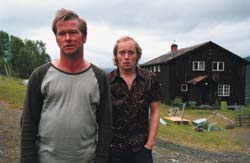Am I really a bad guy?
Middle-aged man, white collar, briefcase in one hand, shotgun in the other. Staring down the barrel of his gun, he despairs: “Am I the bad guy?
In the film «Falling Down», Michael Douglas portrays the character Foster, a middle-aged man in the midst of a complete breakdown. Things are already out of hand when the film begins: He has left his car in the middle of the highway and has headed off on a rampage. Along the way he gets himself a bat, a pistol, and a shotgun, among other weapons. He shoots, bludgeons or blows away anything in his path. Foster is on the way to his little family – a family that no longer wants anything to do with him – and Foster’s intentions are not good.
This is a man who has lost his grip. He doesn’t know what is expected of him. He just knows that he can’t adjust to what the world wants from him – and he becomes angry. Really angry.
Almost thirty years ago, Bob Dylan saw it like this:
“Time is like a jet plane – it moves too fast”
The world is changing and there is only one thing for certain: We don’t know what tomorrow will bring. But we do know that tomorrow will be different than today. The pace of change is speeding up, and man or woman, if you want to play along, you just have to hang in there.
But is there something about men that make them less flexible than women?
In 1996, sociologist Willy Pedersen wrote an article called “The vulnerable sons of the working class», in which he said, “boys and men in many ways are the most marginalized group in today’s society. In a number of areas they are stuck in old-fashioned and inexpedient gender roles … Girls have handled modernity better than have boys”.
Think about it: Girls have adjusted to modern life better than boys. What does it mean?
It means that many boys – and men – are clinging to outdated roles. We men change only if it is absolutely necessary, and change only to silence our critics. Men hold on to what has been, and have a fundamental fear of change, Pedersen said nearly seven years ago. Today his research focuses on other topics, and he has nothing more to say about the subject. But other people have.
“Times they are a-changing”
Is it true that men lack the capacity to change – defined as the ability and desire to change in response to their environment?
Øystein Gullvåg Holter: “This appears to be the case. Undoubtedly, the traditional male role is obsolete, but in many places it is being kept artificially alive”.
We will return to Holter’s ideas. But first: What are the consequences of an inability to change?
Knut Kolnar points to Foster’s reaction in the film “Falling Down” – his response is simply to be violent.
When Foster leaves his car, another driver asks him where he is going. “I’m going home”, Foster answers. What Foster really wants, like many men today, is to return home, to what is safe, to what used to be – but to what is no longer there.
“In my opinion Foster’s violence reflects a kind of nostalgia. He wants to go back to a society he used to be part of, a society he understood. This outdated and superfluous sense of masculinity is a clear foundation for violence”, Kolnar said.
Earlier this year, the Norwegian public was shocked by a series of brutal killings in which the murderers killed their families and then committed suicide. A common factor in each slaying was a man in the midst of a life crisis – a man who responded with fatal violence toward one or several of the people who were closest to him.
These incidents are at the most brutal end of the scale. At the other end of the scale are research results from schools, which show that girls do better than boys in all subjects except for in gymnastics. And there’s more:
Culture: Half of all Norwegian males have never bought a book.
Education: Two-thirds of all undergraduate university students are women.
Family: Women take the initiative to break up the marriage in three out of four divorces.
Drugs: In 2002, men made up 80 to 90 percent of the 600 deaths that were linked to the abuse of alcohol, drugs, or medications.
Traffic: Three out of four fatal road traffic casualties are men.
Suicide: Three out of four suicides are men, and the numbers are even higher among youths.
This situation is not unique to Norway. “Being male is now the single largest demographic factor for early death”, said University of Michigan researcher Randolph Nesse to New Scientist magazine in July 2002.
Perhaps it isn’t so strange that Norwegian boys have an inferiority complex. Consider this excerpt from a secondary school textbook:
A hundred years ago it was an accepted truth that men were superior to women, both physically and mentally However, science has proven this wrong. Given similar circumstances during their upbringing, men have a higher mortality rate, a higher crime rate, a higher rate for drug abuse and violence, and a higher suicide rate. This used to be explained by environmental factors. Today researchers suggest male sex hormones contribute to making men less capable of handling the various challenges in life. (Kosmos 5, page 180)
“We want the world, and we want it NOW”
“Men lack what psychologists call relational competence”, Holter says. By this he means that men focus primarily on their own needs, and not on the needs of others. This becomes a problem when both partner and children expect something different.
But this is not just a family issue.
“There are no indications in current research that men have more friends today than they used to have. We still have the traditional scenario: A man’s closest, and often only friend is the woman he lives with. And if she packs her bags and leaves, his situation is doubly hopeless: The only person he could talk to was the one who just left him”, Holter says.
But he quickly adds that this does not apply to all men.
“There is a great amount of individual variation, and many younger men have a new orientation toward life and work. It is important to determine which groups are at risk and also to identify positive developments. Research is currently underway at the EU and Nordic level – research related to developments in the relations between men, in relation to work, and to gender equality”, says Holter.
OK. Some men (and boys) are more at risk than others. Who are they?
“Express yourself”
Kolnar’s general answer is that those most at risk are men who cannot establish their own identities. Kolnar uses the term ‘identity competence’ to describe the ability to adapt to new social environments. In the future, this will be a determining factor, equally as important as economy and gender equality, for categorising different groups of people.
Identity competence. What does it mean?
Kolnar says that “modern society can be viewed as a kind of lifestyle landscape – a place where you are no longer born into an already established identity but where you have to establish your own identity from scratch. The winners of the postmodern rat race will be those who succeed in creating a functional identity”, he says. We’re talking about the ‘balanced self’ – the winner is the person who is flexible in relation to himself.
This issue is not limited to men. But men may struggle with it more than women. In all cases, the people who manage best are those who have more education and are the most culturally educated.
“The past few decades of gender equality help explain why identity is so important. At the same time we have become a consumer society that offers a host of identities at discount prices”, says Kolnar.
If you are tired of your old image, you can go to Ikea and buy another one.
Kolnar makes reference to a modern cult film, ‘Fight Club’.
“The main character in this film is constantly browsing through Ikea catalogues, looking for something new that can affirm his identity. It’s a picture of a consumer society that incorporates feminine roles as a new part of the male identity: He is effeminate. The main character sees violence as a way to banish effeminate behaviour”, says Kolnar.
For many men, violence is an efficient solution when they feel alienated – it becomes a way to structure reality.
Violence paradoxically serves to stabilize the male image of self. Violence is creative in the sense that it tries to redefine the bounds of identity.
But if certain types of men are at risk of reacting violently in a post-modern society – who are they?
“Come on baby, light my fire”
The author of this article has a friend who has crossed Greenland several times. This friend has told me about a small Inuit village situated between the toe of a glacier and the beach. Here hikers can spend their last night before they return home. It is a well-functioning, small society. There is a hotel, a restaurant, a taxi, and more. It is entirely run by Inuits.
Or more precisely: It is entirely run by Inuit women. Men are inactive most of the year, and often they just hang around getting drunk – except during the seal-hunting season. Then they hunt day and night. The old flame reignites, at least briefly.
These Inuit men, stuck in their old ways, are a classic example of men who lack the capacity for change. They stick to old habits, and have refused to adapt to the new. Is it men with the least education, who live in rural communities, and who work in basic industries who have the most problems?
“These assumptions are too superficial”, says Kolnar, and refers to the fact the there are a great number of people in cities that do not fit in with society at large.
Rural Norway is home to a particularly vulnerable group called ‘mamboes’, a play on words in Norwegian, because it rhymes with ‘samboes’, the slang word used to describe unmarried couples living together. ‘Mamboes’ are men who live with their mothers until they have grown into adulthood, often because they are taking over the farm. “I think that this group suffers the worst problems. We’re talk-ing about a national, male catastrophe zone”, Kolnar says.
Jørgen Lorentzen warns against focusing only on the negative aspects of being a man from a rural area.
“Seen from the city, it may seem that rural areas suffer from more problems, and perhaps that’s true. But we know from research that there are more single people in Oslo than in Finnmark. There are many men in rural areas who have good, close friendships”, he says.
“Looking for trouble? You’ve come to the right place.”
Lorentzen points to another group that seems to be completely marginalized:
“Second generation immigrant boys have severe problems coping with Norwegian society, whereas their sisters can be really successful, for example at Norwegian universities”.
“Clearly these are young men who cling to an outmoded definition of masculinity”, Holter said. This can mean trouble.
But what should men who want to change do?
“A man’s ability to change is related to children”, says sociologist Arnfinn J. Andersen. “Men are capable of the most radical changes when it comes to the demands of caring for their children.”
Andersen works at the Research Council of Norway, and is currently completing his doctorate at the Department of Sociology and Political Science at NTNU. He is studying cases in which the father is the primary parent because the mother is absent. Andersen has great belief in men’s capacity to change.
Andersen’s research subjects – ‘his’ fathers “considered it more important to adopt feminine qualities to keep the family together, rather than to maintain their own masculine image”, Anderson says. “When their relationships ended, they dissolved their traditional relationship with women and took on women’s roles: They showed their feminine sides”.
Andersen refers to a Danish study of men who are the primary caregivers for their children, although they live with the children’s mother. These fathers emphasized all the masculine activities they shared with their children. The fact that the women were still present made them eager to maintain their masculine image. It is only when the women leave the house that men change their image.
“There is not just one, but several kinds of masculinities. I regard gender as something that is flexible and ambiguous, not as something that is predetermined. In this sense masculinity is a historical reality that can be filled with content”, says Andersen.
“Imagine…”
OK. Men are capable of change. And some groups are more capable than others, while others fight change. We are witnessing a polarization: All members of our panel agree on this matter.
Change takes place through learning and through experience. We learn to be men through socialization: We learn with our bodies, not with our heads.
Professor Lars Evensen at the Department of Language and Communication Studies at NTNU has studied this kind of socialization. He calls it tacit knowledge. This knowledge consists of traditions and established habits that are transferred from one generation to the next.
This transfer takes place without people being conscious of the learning process. Evensen points out that tacit knowledge is a two-sided coin, with the unconscious on the other side.
“Tacit knowledge, in a gendered world, cements established structures”, says Evensen. “This is the problem. There is shortage of innovation. Therefore it is of paramount importance to actively and critically reflect on one’s own qualifications – this is how one becomes innovative”.
So what should men do about their own sons? Evensen responds without hesitation:
“Teach them to question things!”
Ready for the scrap heap?
Is traditional masculinity ready for history’s scrap heap? Norwegian men’s studies researchers are inclined to answer yes. But are men able to change in response to their surroundings? The following researchers – all men – try to come up with their individual answers:
Øystein Gullvåg Holter
is a sociologist working at the Work Research Institute in Oslo. Among his current research projects is ‘Masculinity, welfare, and social innovation.’
Knut Kolnar
is a philosopher and researcher at Lund University. In his doctoral dissertation at NTNU, ‘Violence and sexuality’, he analysed the different causes of violence and how violence is connected to sexuality.
Arnfinn Andersen
is a sociologist, and in his doctoral dissertation he discusses how fathers create a social and symbolic structure connected to parenthood and family outside the context of heterosexual relationships.
Lars S. Evensen
is a professor at the Department of Language and Communication Studies at NTNU. He has headed the research project ‘IKT@Babel’ which deals with socialization processes.
Jørgen Lorentzen
is a men’s studies researcher at the Centre for Women’s Studies and Gender Research at the University of Oslo, where he is a project coordinator for the umbrella project ‘Men and masculinities’, of which Holter’s project is a part.
Text: Tore oksholen





